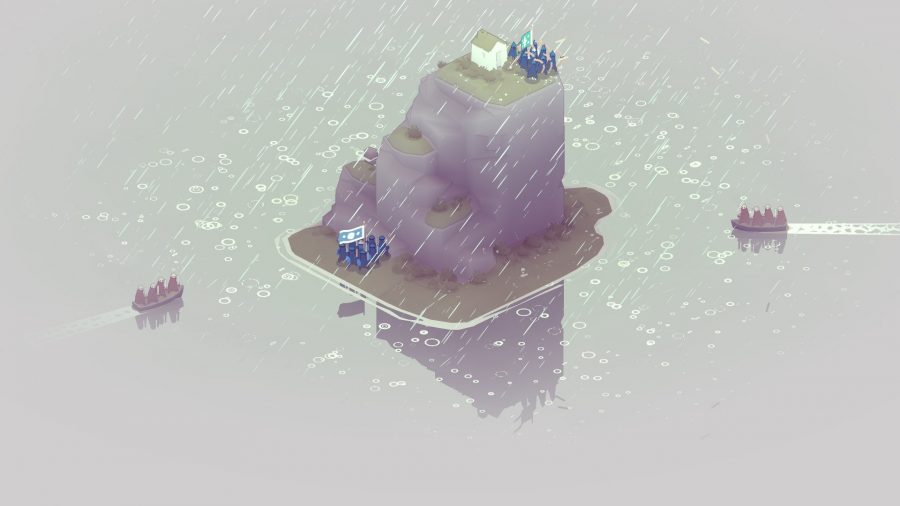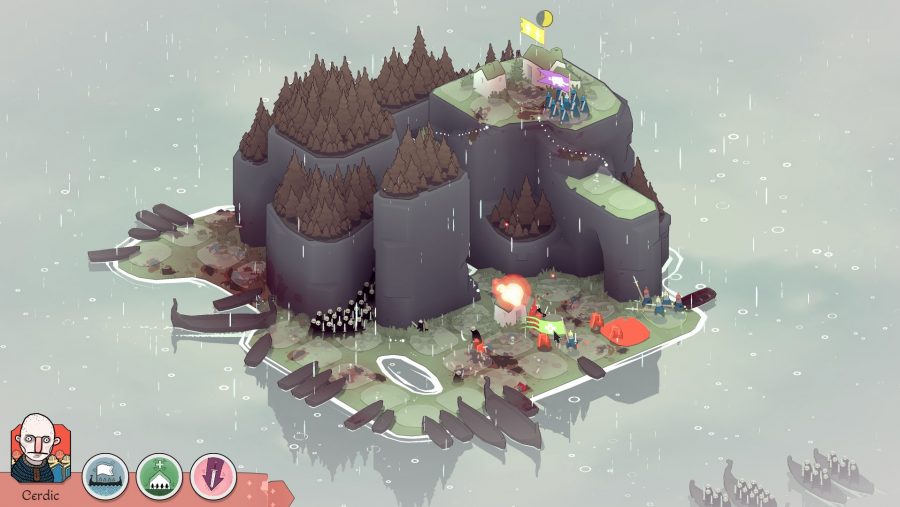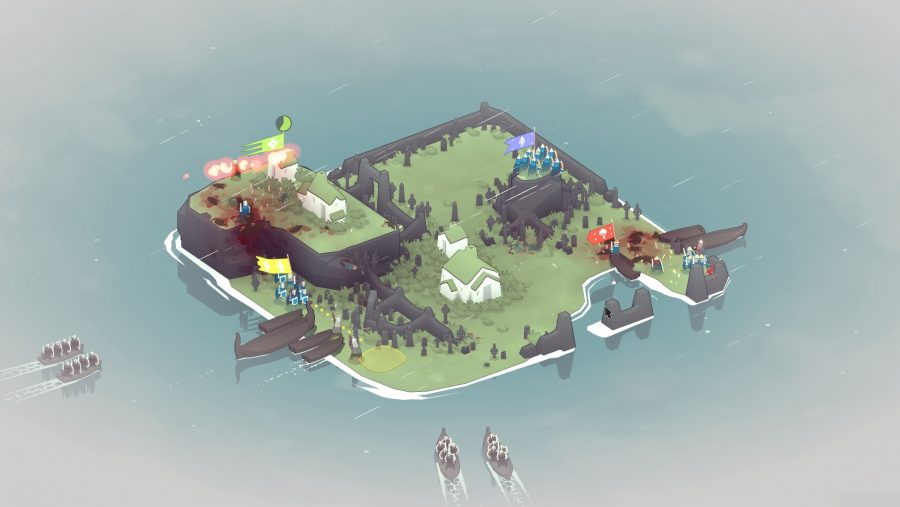“It’s grim up north,” it’s said in the UK – often sardonically by northerners. They don’t know the half of it. We’re north of north now, where the hills are high and craggy – a reflection of the people that live between them, constantly bracing for outside intrusion. The pines are tall and spiky, just like the pikes we’ve fashioned from their branches. I’m grateful for these natural defences against the oncoming assault. We stand on the beaches, sharp sticks pointed outwards, ready to poke the invaders back into the cold seas. Or failing that, make enough holes in them that they stop climbing.
Discordant horns jeer from the horizon, or at least where the horizon ought to be – the fog is so thick that we can hear our enemy before we see them. Black-clad and white-helmed, reminiscent of Spirited Away’s No Face, the marauders crash against the shore like waves. I can see my tiny soldiers fidgeting in their ranks, buckling under the onslaught of Viking bodies. But they don’t break, this time. Our beautiful yet cruel land, once a pristine Scandinavian white, is now coated in the blood of outsiders.
This is home, but we cannot stay. The force we’ve seen off is simply the vanguard – the army that follows is large enough to envelop any defense we could muster. So we press on, sailing from island to island, turning our weapons outward each time, picking up new comrades to replace those who’ve disappeared beneath the Viking waves. It’s grim, but that’s the north.
On release, Bad North was a timely reminder that the RTS games genre was neither dead, nor struggling – it’s just become far broader than the standard definition allows for. There may only be a handful of studios making games that resemble StarCraft or Age of Empires these days, but their influence is everywhere. Just as Midgard was created by the gods from the body of the giant Ymir – his flesh the land, his bones the mountains, his teeth the cliffs, his blood the oceans – every part of the ‘90s RTS has been taken and reapplied by its younger successors.
The carefully maintained flow of resources that defined Age of Empires can be found in Frostpunk, where a night without coal can leave your workers without legs. The hurriedly assembled barriers and counters of a classic RTS skirmish have been put to work in the tactically hectic Orcs Must Die! And the timeless joy of turtling is represented by They Are Billions.
Bad North takes its own chunk of flesh from the genre, the micromanagement of units, and doubles down on it. Click on a formation of archers and time will slow, the dioramic island you’re defending revealing itself to be made up of many grids. You pick one and, essentially, that’s it. In total, 90% of the game is positioning, with the remaining 10% reserved for special abilities, like bombs that explode with the charming crash of a symbol. Bad North is as cute as it is cold.
Like Total War: Arena, the surprisingly excellent competitive strategy spin-off, Bad North finds strength in simplicity – you’re never controlling more than four units at once. If you ever sighed in frustration after forgetting to queue any villagers for 20 minutes, this one’s for you. There’s no scrolling in Bad North at all – with every ally, enemy, building, and chokepoint appearing in the space of a single screen, there’s no need for that functionality.
That might not sound like a lot to do, but in practice Bad North exists in a thrilling sweet spot – constantly threatening to tick over into ‘too much’. Tension is derived from watching your pikemen hot-foot it to another beachhead, hoping they’ll get there in time. If they manage to set up sticks, so to speak, they’re nigh on invincible; if the enemy manages to catch them mid-jog, they’re next to useless.
It’s a similar story with counters: your finest shieldbearers can’t match embedded pikemen, but but can stand against any archer. Unless, of course, an arrow happens to nick them from behind. This is what makes Bad North so replayable – like the ocean around it, these units are subject to a mass of tiny calculations that can sometimes produce unpredictable results, trumping the broad rules you think you know.
A single, straggling archer still climbing a rock might keep your soldiers occupied an extra second or two, preventing them from turning to face the next threat. A particularly tough enemy might prove less so if you set up on a cliff to knock them, with a satisfying plop, directly into the water. You can be caught out, or take advantage.
The success of Orcs Must Die! made sense – it was put together by Ensemble refugees who’d spent over a decade shaping the RTS. Bad North is made by a first-time indie developer.
Since writing that last sentence I’ve googled again to check, because I can’t quite believe it – that such a confident rework of old ideas, aesthetically clean and mechanically messy in all the right places, could possibly come from a new studio. Yet it has, an against-the-odds story rather like that of my Viking impalers. I hope Plausible Concept can do it again and again, defending each new island of an idea with the same bold, fearless approach.
"strategy" - Google News
September 12, 2020 at 04:24AM
https://ift.tt/3imEe6J
Why every strategy fan should try Bad North - PCGamesN
"strategy" - Google News
https://ift.tt/2Ys7QbK
https://ift.tt/2zRd1Yo
Bagikan Berita Ini


















0 Response to "Why every strategy fan should try Bad North - PCGamesN"
Post a Comment